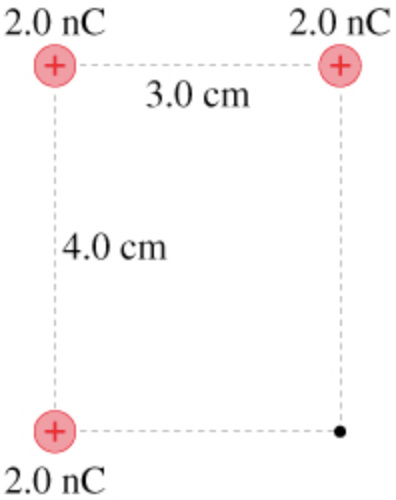Question
In: Physics
What is the electric potential at the point indicated with the dot in (Figure 1)?
What is the electric potential at the point indicated with the dot in (Figure 1)?

figure 1
Solutions
Expert Solution
Potential at given point due to point charge \(=\mathrm{kQ} / \mathrm{r}\)
Potential at a point due to multiple point charges \(=\mathrm{kQ}_{1} / \mathrm{r}_{1}+\mathrm{kQ}_{2} / \mathrm{r}_{2}+\mathrm{kQ}_{3} / \mathrm{r}_{3} \ldots \ldots\).etc
From the figure
\(V=k Q / r_{1}+k Q / r_{2}+k Q / r_{3}\) as all the charges are equal
\(V=k Q\left(1 / r_{1}+1 / r_{2}+1 / r_{3}\right)\)
\(r_{1}=3 \mathrm{~cm}=0.03 \mathrm{~m}\)
\(r_{3}=4 \mathrm{~cm}=0.04 \mathrm{~m}\)
\(r_{2}=\sqrt{\left(r_{1}^{2}+r_{3}^{2}\right)}\)
\(\Rightarrow r_{2}=\sqrt{\left(0.03^{2}+0.04^{2}\right)}\)
\(\Rightarrow r_{2}=\sqrt{(0.0025)}\)
\(r_{2}=0.05 \mathrm{~m}\)
\(Q=2 n C=2^{*} 10^{-9} C\)
\(\mathrm{k}=9^{*} 10^{9} \mathrm{Nm}^{2} / \mathrm{C}^{2}\)
\(V=9 * 10^{9} * 2 * 10^{-9}(1 / 0.03+1 / 0.05+1 / 0.04) V\)
\(\Rightarrow V=18 * 78.33 V\)
\(\therefore V=1410 \mathrm{~V},\) which is the required solution
Related Solutions
What is the electric potential at the point indicated with the dot in the figure?
what is the strength of the electric field at the position indicated by the dot in the figure?
What is the electric potential at point A in the figure?
What is the magnitude of the electric field at the dot in the figure? (Figure 1)
What is the direction of the electric field at the dot in the figure (Figure 1) ?
What is the magnitude of the electric field at the dot in the figure?
Determine the magnitude and direction of the electric field at point 1 in the figure(Figure 1).
What is the electric potential energy of the group of charges in the figure?
What is the electric potential energy of the group of charges in (Figure 1)? Assume that q = -5.5 nC.
Which of the following statements is incorrect? 1. The electric potential at a point due to...
- Suggest a policy aimed at encouraging female workforce participation and briefly explain how it might achieve...
- Assume the branch manager is not satisfied with the widths of the obtained confidence intervals, and...
- Using the following equation (Debye-Huckel), find the coefficient of activity of the following: a) Fe3+ with...
- Questions: The densities of ice and water at 0 °C are 0.9168 and 0.9998 g cm–3,respectively....
- A man stands on the roof of a building of height 16.8m and throws a rock...
- How would YOU define identity (in a historical not a personal context) and in what ways...
- 5) The demand for a good varies A) directly with the prices of substitutes and also...
 Dr. OWL answered 4 years ago
Dr. OWL answered 4 years ago